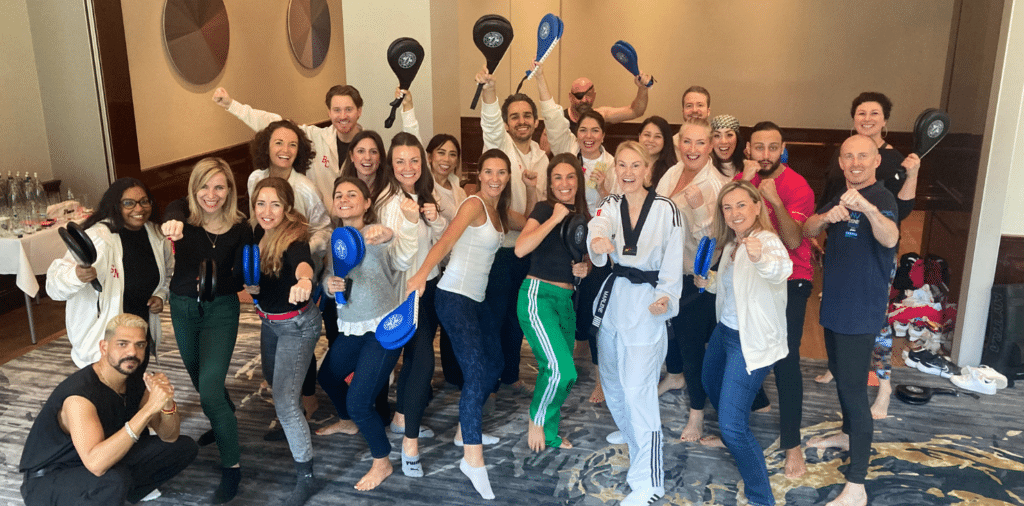Elevate Your Workforce: Best Practices in Training and Development

Whether you’re training Olympic athletes or spearheading a start-up destined to be the biggest name in your industry, knowing how to lead a team to success takes consistent work. You could have been in the game for decades, or perhaps it’s your first time taking on a manager’s role. Either way, understanding that true leadership means leaving room for growth is crucial to becoming the best leader you can be.
This article covers all the bases so you can elevate your workforce through best training practices and career development. We take a deep dive into the advantages of enhancing training programs, all the essentials of upskilling, the barriers, and how to assess its effectiveness. We also provide information on some of our most world-renowned training and development programs here at WDHB.
Advantages of Enhancing Training and Development
Whatever your career path, we are all in a constant state of learning. Continuous learning keeps our jobs interesting, ensuring we broaden our skill sets, get better at what we do and add value to the workplace. When it comes to a leadership role, you have a whole lot more responsibility to guide a team or group in the right direction – towards a common goal or desired outcome.
In order to be the best leader you can possibly be, ongoing training practices and development are the surest way to get there. Knowing how to enrich our employees’ experience increases their productivity and performance. Quality learning opportunities also help ensure that people want to stay with the business for as long as possible.
Most of all, enhancing training and development aids in increasing employee engagement, recruitment and retention as well as productivity and job performance.
Essential Best Practices for Successful Training and Development
Before you begin improving training practices, you need to review the existing gaps in you and your team’s performance. Then, decide on your desired learning outcomes and determine the best format to deliver that training. After a learning module is completed, assess the training program’s effectiveness as you make future improvements.
Conduct a Needs Assessment
It’s challenging to know where you want to get to if you don’t know where you’re starting. By conducting a training needs assessment, you can define skills gaps within your organization and address them with the proper learning solutions. Your goal is to identify the specific skills, qualities, and development areas required for you or your team and follow up with a training and development program that best reflects that.
Ask yourself the question, does everyone in your organization have access to the same learning opportunities? Are there clearly identified learning paths for each individual employee? Is there a healthy learning environment for team members that supports their professional development goals? Considering each team member’s needs ensures that you have the right training courses available to them.
Set Clear Objectives
It’s one thing to know what you want the outcome of your training and development to be, but you also have to set out the steps needed to achieve that goal.
Be certain that these steps are realistic, achievable, and aligned with the organization’s values and objectives. For example, the goal for your training could be to teach new recruits how to use a lead management system. One of your objectives might be to secure the people and resources you need to successfully kick off this program. You might also strive for twenty new recruits per month to receive this training. Your objectives need to be specific and measurable.
Choose the Right Training Methods
When enhancing training and development in your workplace, consider that each employee has a different learning process. While one person in the course may be a visual learner and require an interactive experience, others may rely on detailed written explanations to grasp a concept.
Training content should be flexible and versatile. Tailoring training methods to suit a range of different learning styles and learning levels is a must if you want positive results. Webinars, mentoring, quizzes, e-learning and more can be included in a training plan to encourage employee development and knowledge retention.
WDHB offers a range of customizable options to suit all learning styles. From experiential programs, like our Learning Expeditions, to immersive learning experiences in our Strategic Summits, we can customize the right solution to suit your needs We also offer online learning with our Hybrid & Virtual Leadership Training Solutions.
Engage Employees in the Training Process
For employees to gain something from career training and development, they need to be engaged. Experiencing learning with all of the senses, encouraging discussions, and engaging in problem-solving activities motivates people to think critically and retain more information. Employee engagement is also about applying knowledge to real-life situations. This experiential approach to learning encourages your people to continue using their new-found knowledge and skills in the workplace.
Challenges to Be Faced
While remaining positive about the potential for learning and development programs to elevate your workplace, it’s also vital to consider the roadblocks that can come up. Learning how to manage these common challenges will help you make the most of your learning experience.
Resistance to Change
Old habits die hard. Your team may struggle to adapt to changes encouraged by learning and development if their mindset is focused on “the way things have always been done.” Communicating the necessity of change into your employee training is a great way to ensure that your people are prepared to change with the times.
Introducing learning management systems and knowing how to show leadership in times of adversity is a vital skill to learn. Often, change can land you in a much better position than you anticipated.
Lack of Resources
Leadership and development training can often go amiss because of a perceived lack of resources. Adapting and using existing resources in these situations is critical. The path to success may look slightly different than you had expected, but you can still find a way to reach your desired outcome. .
Open-mindedness and a willingness to ‘make do’ at times like these are crucial to overcoming challenges and remaining focused on the end goal. Coming up with strategic plans that are focused on problem-solving and the learning needs of others is a must if you want to eradicate leadership gaps and identify development opportunities.
High Employee Turnover
Employee retention is a focus for many employers or people in leadership roles. It’s important to remember that training and development is one of the best ways to keep employees engaged and on board with the organization’s long-term goals. Giving employees opportunities to learn and upskill through training and career development shows that there is potential for growth within the organization. Investing in employee training also shows your people that you see their valuable role in organizational success.
How to Assess the Effectiveness of Training program
Measuring how well a learning process has worked helps you determine the impact. You can then decide whether or not to continue with the program, consider alternatives, or improve programming to find more success at achieving your objectives.
Training effectiveness can be tracked through several different measuring methods. Possible options include the following:
- Determining the return on investment and deciding if the time and effort put in have paid off
- Assessing employee completion rates
- Measuring qualitative improvements in employee knowledge and skills
- Carrying out employee surveys or conducting interviews
- Using metrics like key performance indicators (KPIs) to get a gauge on how beneficial it was for employees and the organization as a whole.
By measuring what has and hasn’t worked,training managers can make more informed decisions the next time they invest in training and development programs.
Effective training covers a wide range of organizational needs, from identifying skill gaps to starting new initiatives and helping employees earn certifications.Check out our Complete Guide to Evaluating Training Effectiveness for more insights.
WDHB Training and Development programs
We believe that people are the most powerful agents for change and growth. For over 30 years, the impact of authentic testimonials, compelling stories and memorable hands-on experiences has been at the core of all we do. As we partner with clients around the globe, we live to create meaningful programs that put people at the center of business strategy. Here’s a list of some of our most attended programs.
- Apollo Leadership Experience – Achieving the Impossible
- Encore Leadership Experience – Building Harmony Within Teams
- Gettysburg Experience – Influencing Under Pressure
- Gold Medal Leadership Experience – Driving High Performance
- Launch Point Leadership Experience – Innovating for the Future
- Normandy Experience – Managing Complexity During Chaos
In Conclusion: Emphasizing the Importance of Continuous Improvement
To achieve meaningful growth and development, we must be willing to learn consistently. While it may feel like the safest option to stay where we are in our careers and not face any challenges, the greatest success comes from testing our limits and wanting to be the best we can possibly be in our roles. Luckily, we don’t have to figure it all out on our own.
There are impressive advantages to enhancing training and development in your organization. While challenges may come up along the way. implementing best practices in training and development allows us to take our success to new heights. Now, it’s up to you to put learning into practice.
Author
Subscribe to get Access to Exclusive Content





